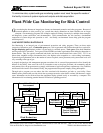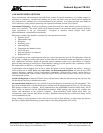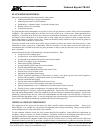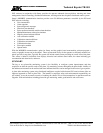
Technical Reprint TR-001
Sierra Monitor Corp. 1991 Tarob Ct., Milpitas, California 95035 USA 408-262-6611, 800-727-4377 FAX: 408-262-9042
Visit our Web Site at: http://www.sierramonitor.com E-Mail: sales@sierramonitor.com
PLANT-WIDE MONITORING
Plant-wide gas monitoring offers many benefits, among them:
• Centralized monitoring of all gas measurements
• Monitoring the status of control elements
• Establishing a “command center” to respond to alarm events
• Remote access to all system data
• Centralized reporting
In a plant that has been instrumented over a period of years, the gas detection system is likely to be an autonomous
installation. The controller might be in the field close to the sensors or in a control room. Both approaches have
limitations. Controllers in the field do not transfer gas concentration information to the control room. Alarm data
are limited to local annunciation of an alarm event, or long wiring runs are required in order to report sensor-by-
sensor alarm status to a central control room. Alarms are therefore usually limited to relays activated by groups of
sensors and/or field controllers in a given area.
Controllers located in the control room usually require extensive wiring to the sensors and alarm activity is often
minimized to reduce wiring cost. Furthermore, when the controller is in the central control room, there are no
concentration data available in the field for plant personnel to make on-the-spot decisions; only an alarm light or
horn is activated.
Systems designed for plant-wide monitoring avoid these deficiencies. They:
• Accept sensors for multiple gases
• Accept sensors from various manufactures
• Accept other environmental and process sensor measurements
• Provide local display of gas concentration
• Permit auto-adjusting calibration
• Accept feedback signals from final control elements
• Provide independent battery backup
• Allow low-cost communications link to the control room
• Provide relays for local alarm action
• Implement user-defined alarm strategy
• Provide centralized monitoring of sensor status as shown on the plant log plan and at each operation /
facility with bar graphics, configuration screens, and real-time trends
• Provide centralized data logging
• Provide alarm acknowledgment from the control room
• Allow access to control room computer from other sites in facility
• Operate independently even if communications with the control room are severed
• Provide for easy system reconfiguration via computer at the control room
Distributed intelligence is central to system design philosophy. Because the field controllers can implement alarm
logic and operate independently of the host computer, they do not interrupt or hamper field operation. A plant-wide
monitoring system provides the user with clear, understandable data that make it possible quickly to analyze the
situation and take appropriate action. A correctly designed plant-wide monitoring system offers the best features of
local control, and centralized monitoring systemizes the entire monitoring process.
CRITICAL SYSTEM COMPONENTS
The components of the system are the sensors, the field controller, and the monitoring software. Sentry, from
Sierra Monitor, is an example of a system that can implement plant-wide gas monitoring. The gas sensor modules
can be multiplexed on a single cable back to the controller.
To offer complete solutions at each site, field systems need full I/O capability. Sentry fulfills this requirement by
accepting a variety of sensors or 4-20 mA transmitters. The Sentry controller is an intelligent device that can access
the sensor modules for diagnostic data, non-intrusive calibration and gas concentration information.
MODBUS communications interface enables Sentry and the IT Series sensors to easily interface with a PC-based
Distributed Control System (DCS) providing a graphical display of hazardous gas conditions in the plant. PC-based






